Exposition
“There is no greater peril to sons of men born than the breakers of oaths called the Watchers of Thorns”
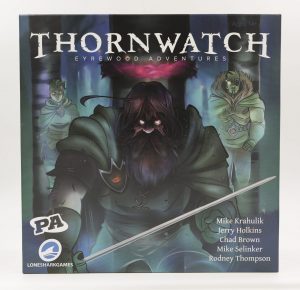 In 2009, the creators of the webcomic Penny Arcade, Mike Krahulik and Jerry Holkins, journeyed on a side quest into a setting that would become a deep well of legend and lore known as the Eyrewood. The Eyrewood is a magical, fantasy forest in which the people must contend with the creatures, both benign and malignant, that dwell within the wood. Their first Eyrewood comic strip, Lookouts, was a “one-page treatment” to gauge audience response on a comic that was vastly different from their standard 3-panel topical comedy strip.
In 2009, the creators of the webcomic Penny Arcade, Mike Krahulik and Jerry Holkins, journeyed on a side quest into a setting that would become a deep well of legend and lore known as the Eyrewood. The Eyrewood is a magical, fantasy forest in which the people must contend with the creatures, both benign and malignant, that dwell within the wood. Their first Eyrewood comic strip, Lookouts, was a “one-page treatment” to gauge audience response on a comic that was vastly different from their standard 3-panel topical comedy strip.
The response was overwhelming and over the next several years they continued to craft new stories about the denizens of the Eyrewood and the factions at play in it. One of those factions is the Thornwatch, a guardian force of spirits who are summoned in moments of great need when thorny vines are tied in a special knot around a tree. The spirits are the vestige souls of oathbreakers forced to guard and protect after death in order to finish out their oaths.
Krahulik had been tinkering with the idea of making a card based role-playing game around the same time (circa 2011), so using the Thornwatch and Eyrewood as the setting only made sense. Development began in-house at the Penny Arcade offices with a core group of staff working on the alpha version during off-hours and lunch breaks. In 2015, the first public playtest at PAX East occurred and was the spotlight of the finale of their popular “PA: the Series” documentary series.
These early versions appeared to be more close to a traditional role-playing game with character creation and a number-based difficulty rating. But, with feedback from the many playtests, the game morphed again and again into a more abstract storytelling adventure game.

In 2016 a Kickstarter campaign for the much-anticipated game was announced by Lone Shark Games, with delivery expected in late 2017. The campaign was a huge success and Thornwatch was on its way. Of course, as with almost every Kickstarter campaign, the completion time was underestimated and the game came out close to a year late.
So, finally, after seven years of development and production, the Thornwatch have been successfully summoned into existence. But was it worth the wait?
The Rise
“Seek not the bramble, no wreath will bring good; tie ye no knots in the frost-haunted wood.”
Thornwatch is very much true to its setting, bringing these mysterious spirits, the people who summon them, and the malevolent forces that seek to destroy them to your tabletop. The artwork is gorgeous and fits the setting wonderfully. The characters are all in Krahulik’s illustrative comic style, while the map tiles are in an impressionistic, painterly style that actually helps the characters to stand out (in the exact same way that the backgrounds of an illustrated scene will often be out of focus to create depth and focal points). Clearly, this was the brainchild of an artist.
Players take on the roles of the Judge and the heroes of the Thornwatch that have been summoned. The Judge is very much in the same role as the Game Master or Dungeon Master from traditional RPGs. That player chooses the story to be played, sets the board, controls all non-player characters (NPCs), and tracks the Momentum of the game (more on this in a minute). What sets it apart is that the Judge has a character as well that defines how they play. Will you choose the passive, manipulative Judge of Stars or the predatory, aggressive Judge Below?
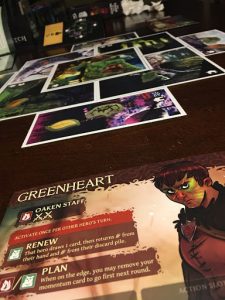 The Thornwatch heroes choose from five archetypal roles, Guard, Blade, Warden, Sage, and Greenheart. Each is defined by two skills (out of five total) that they possess. The Guard focuses on Brawn and Agility while the Sage brings Mind and Spirit to the table echoing the traditional fighter and wizard roles. The Warden and Greenheart switch out Agility and Mind to take on the ranger and druid roles. The Blade picks up those two skills as the clever rogue of the bunch.
The Thornwatch heroes choose from five archetypal roles, Guard, Blade, Warden, Sage, and Greenheart. Each is defined by two skills (out of five total) that they possess. The Guard focuses on Brawn and Agility while the Sage brings Mind and Spirit to the table echoing the traditional fighter and wizard roles. The Warden and Greenheart switch out Agility and Mind to take on the ranger and druid roles. The Blade picks up those two skills as the clever rogue of the bunch.
Skills are used to power Actions that range from basic attacks to defense/healing to board/turn control. Each hero has some basic Actions on their Tracker playmat (double-sided with male and female portraits) and then a Character Deck that has additional Actions along with the skill cards needed to power the Actions. Heroes take turns drawing cards, powering up actions, and then using them. The Judge has Ebb (the dark, corrupting power of the Eyrewood) to power their denizens’ actions as well.
Actions are often resolved with a number of ten-sided dice depicting blood drops (Hits), blanks (Misses), and spirals (Ebb). Hits deal wounds, misses do nothing, and if a hero rolls an Ebb the Judge gains another Ebb token to be used.
There is also a special red Focus Die that has better Hit odds and no Ebb faces. In order to be able to use the Focus Die, a hero must depict through their actions and words one of the two personality traits that have been dealt to them randomly at the beginning of the game. This encourages role-playing and adds excitement to the game.
 The game itself revolves around the Momentum track to determine turn order. Momentum is a dynamic initiative tracking system that uses card markers to show where a character’s turn is in relation to everyone else. Unlike a traditional initiative countdown, characters move along the track from the Root to the Edge based on the actions that are taken.
The game itself revolves around the Momentum track to determine turn order. Momentum is a dynamic initiative tracking system that uses card markers to show where a character’s turn is in relation to everyone else. Unlike a traditional initiative countdown, characters move along the track from the Root to the Edge based on the actions that are taken.
As monsters take wounds they are knocked closer and closer until they are finally pushed over the Edge and killed. However, if the group can’t manage to get an enemy over the Edge by the end of the round it may make a comeback as all Momentum cards are shuffled and laid out again to start a new round. In this way, the monsters wounds aren’t counted, they are just as resilient as the Momentum of the battle allows. This is a great mechanic that makes every round fresh and forces the Thornwatch to strategize how they can best use their Actions to push the monsters over the Edge so they don’t come back.
In a similar way, the Thornwatch’s wounds aren’t counted individually. They do gain wounds, but these are represented as cards that are added to the Character Decks as the Thornwatch takes damage. The Wound Cards are not usable by the Thornwatch players and thus take up a useful spot in the player’s 5-card hand. This can delay Actions from being played and powered. It really emphasizes the fatigue setting in as they are wounded. When the Wound Deck is empty, the spell that summoned the Thornwatch is broken and the scene ends in failure.
The game is designed to be played in multiple-scene adventures campaigns and each scene is unique enough to make the decision of what to play difficult; though playing through a single scene game is enough. The information for each scene is printed on a storyboard intended to be folded into a tent and used as a reference for the Judge. The storyboard provides some flavor text, a comic page (it is a graphic novel adventure game afterall!) with the story, and setup for the board as well as additional rules. The conditions for how the scene ends and where the adventure goes depending on the outcome are also included.
The Fall
“Tis better to bleed and to be made unborn than to summon the devils called Watcher of Thorns.”
Thornwatch is a solid game; but it does have some flaws. None of these make the game less enjoyable or playable, but they are areas for improvement that could be resolved in either the next Eyrewood Adventures game or with a second edition.
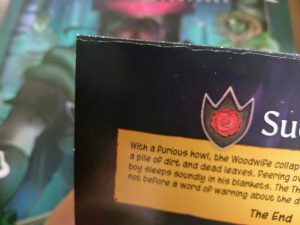 There are a few ways that the storyboards could be improved upon. Let’s start with the coating on the boards: it tends to crack and buckle when the boards are folded as intended. It also makes the boards hard to stand up on a smooth surface. Secondly, there’s not an example in the rulebook about how these are to be folded or what way they are supposed to face when stood up. It’s a minor thing, but it was confusing when first opening the box. The last way the storyboards could be improved on is to provide some basic tactics of the NPCs for the judge. As an example, in The Woodwife’s Bargain, it wasn’t clear on how the Oaken Defender and Woodwife worked together. A small paragraph about their tactics would have helped clarify things and made for a smoother playthrough.
There are a few ways that the storyboards could be improved upon. Let’s start with the coating on the boards: it tends to crack and buckle when the boards are folded as intended. It also makes the boards hard to stand up on a smooth surface. Secondly, there’s not an example in the rulebook about how these are to be folded or what way they are supposed to face when stood up. It’s a minor thing, but it was confusing when first opening the box. The last way the storyboards could be improved on is to provide some basic tactics of the NPCs for the judge. As an example, in The Woodwife’s Bargain, it wasn’t clear on how the Oaken Defender and Woodwife worked together. A small paragraph about their tactics would have helped clarify things and made for a smoother playthrough.
Another interesting flaw is in the light roleplaying element of the game. When character creation was removed (seemingly in favor of faster setup time) the heroes were abstracted to their classes. On top of this, the randomly dealt personality traits are also fairly abstract. The players don’t really have a sense of the character they are playing so they tend to either not roleplay at all or “spam” the traits in order to get the focus die. It feels like an afterthought on top of a tactical combat game.
Lastly, the box for the game has great artwork on it, but the lack of organizational elements inside is disappointing. There is a cardboard tray that is wider than the cardstock dividers that come with the game causing them to slide back and forth. It’s also too long for the amount of cards so they tend slide down unless you make a pile of tokens and dice in front of them. That’s the only bit of organization. The vast amount of cardstock tokens, character trackers, and storyboards all just lay in the bottom of the box and slide around when it’s stored on a shelf.
All of these are fairly minor quibbles that are easily overcome with a bit of customization and the game is still a lot of fun out of the box.
Resolution
Thornwatch is a storytelling tactical adventure game with a bit of fresh air to it. The mechanics have been well thought out. If you are a fan of this genre, you should give this one a try. It’s not exactly a roleplaying game, but it has enough elements to get it pretty close.
The artwork is definitely another draw. If you are a fan of games with great style and art direction you will enjoy having this one on your shelf.
Finally, If you are a fan of Penny Arcade and the Eyrewood setting you should definitely pick this up as it really is a faithful game set in that world and, from the sounds of it, there may be more Eyrewood Adventures down the road.
Author’s Note: The verses used in this article are from the original Thornwatch strips by Penny Arcade and the poem that Eyrewood parents use to caution their children from calling on these oathbreakers for aid. They, along with all of the Penny Arcade strips, can be found here: www.penny-arcade.com/
Thornwatch is available for purchase now at lonesharkgames.com


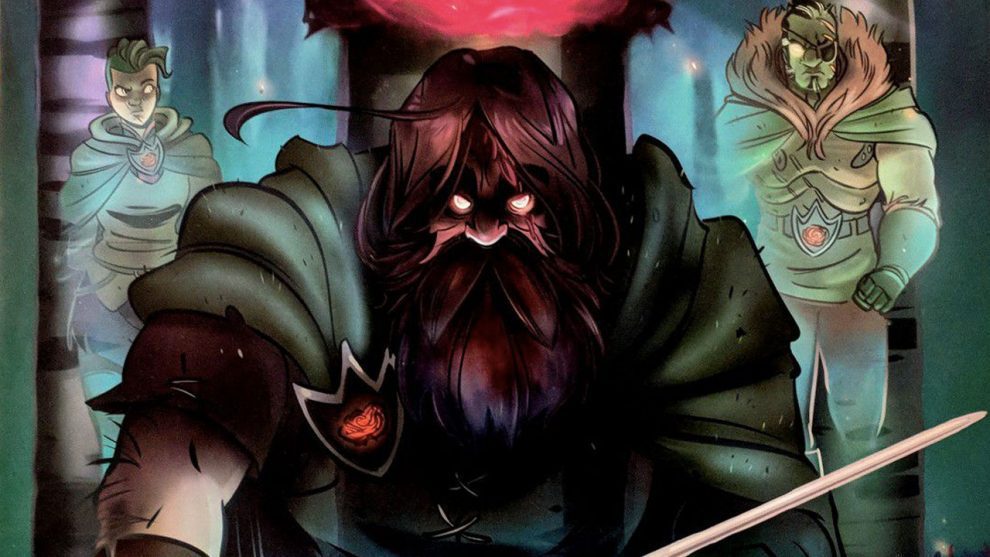

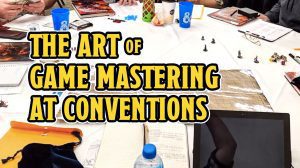







Add Comment